
Hover Over Me!
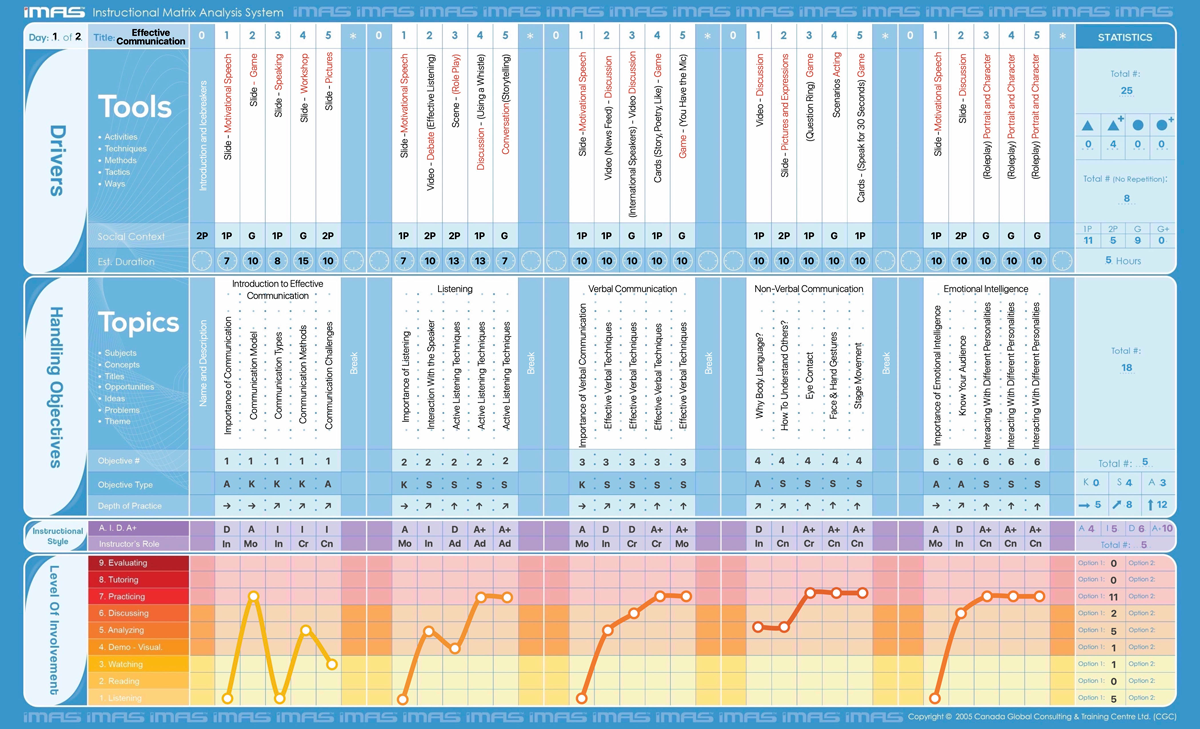
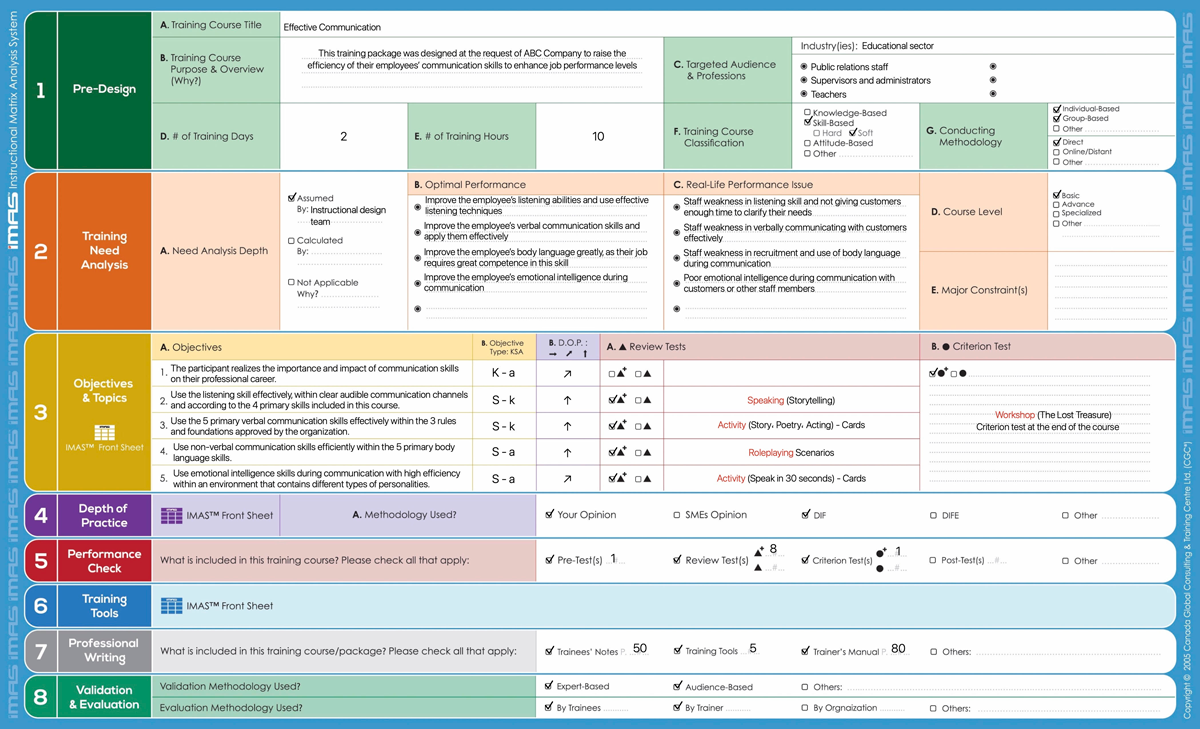
Back Title
– Inconsistent training delivery
– Ineffective training & training package design
– Unmeasured trainee performance.
IMAS™ addresses these issues and ensures training objectives are met by implementing an innovative dashboard, monitoring and measuring trainee performance through an application-focused training design, assessment tools, milestones, and performance checks to guarantee effective and efficient skill transfer, improving business processes and creating a proficient workforce to achieve maximum training ROI.
Why IMAS™?
We believe that measured performance and systematic training lead to effective and efficient business processes and workforce. Hence, we present:
Instructional Matrix Analysis System
IMAS™ consists of 8 stages that provide clear and systematic course creation, multiple checks and balances, measurable performance checks, and training effectiveness to help organizations:
● Meet training objectives by making the trainer conform to the training scenario and providing consistent training delivery, reducing wasted time and energy and avoiding unnecessary activities.
● Reach maximum training ROI by enabling measurable assessment tools for the trainer to fine-tune training scenarios and ensuring effective training through an application-based design.
● Improve workforce proficiency and business processes by providing the trainer with milestones & performance checks to guarantee skill transfer, ensuring skill retention through measured trainee performance.
What is IMAS™?
● Creating systematic, flawless, effective, and consistent training to solve observed instructional design and training delivery issues.
● Enabling course preparation, training analysis, and quality control throughout an 8-stage, step-by-step process that aims for minimal wasted efforts.
Every training package designed by IMAS™ addresses a performance gap and integrates performance-based proficiency tests to ensure skill transfer and return on investment (ROI).

Training tools:
Purposeful selection & use of various training tools help pass knowledge, skills, and attitudes to participants.Active training tools are what distinguish training from academic learning.
Ice Breakers:
Each hour can start with an Ice Breaker or its equivalent. It has numerous uses, including melting away tension and energizing the brain.Social Context:
The fluctuating levels of socialization and group work of the training activity maintain energy in the training environment.The Social Context is compatible with the training tool and Depth of Practice vertical-wise.
Horizontally, it shows how connected the participants are with each other throughout the training day.
Allocated Time:
Allocating appropriate time duration to each training activity has never been easier.IMAS is compatible with various timing methodologies whether you follow the common 10x5, 15x3, 25x2 rules, or even the uncommon 7x7 rule.
Thus, you are in control of your training session.
Participant Involvement:
Selecting the right training tool can best be described as hectic.No more! With IMAS, each training tool is classified by its brain-activity involvement.
Now, professional trainers can make calculated decisions when selecting training tools to guarantee participation & involvement as well as to drive performance in their training sessions.
The 3 Dimensions of IMAS™
Contains time management and essential components covered by the training package within the allocated period.
Depth Dimension
Processing of the basic components within the appropriate tools in their respective stages:
● Drivers: Methods, tools, techniques, activity duration, social context.
● Handling Objectives: Topics, depth of practice, Objective number and type.
● Instructional Style: Instructor’s role, role type, trainer style.
● Level of Involvement: participant activity type, attention and crowd energy management, participant involvement.
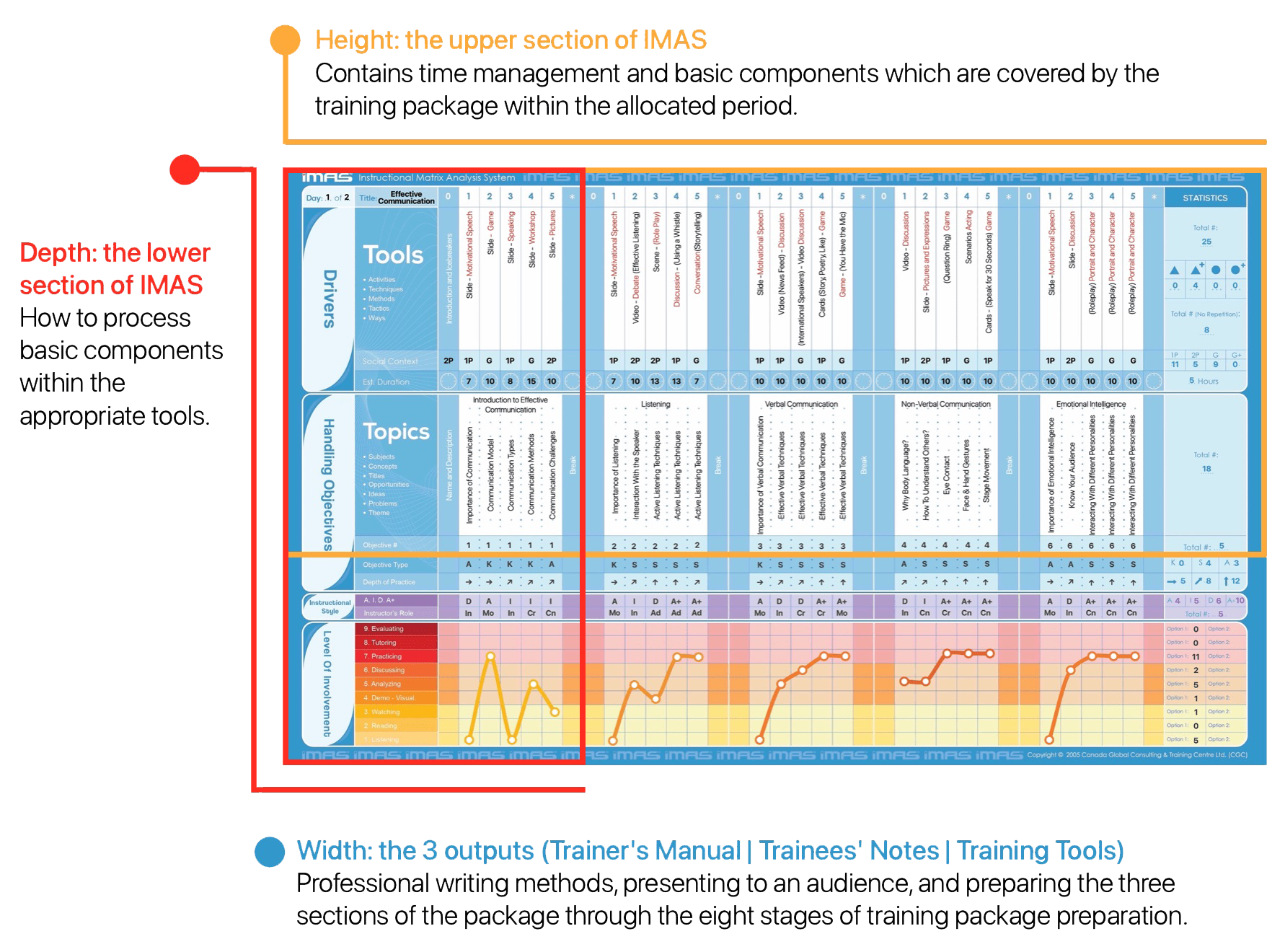
The 3 Outputs (Trainer’s Manual | Trainees’ Notes | Training Tools):
● Professional writing methods.
● Presenting to the audience.
● Preparing the three sections of the package throughout the 8 stages IMAS™.
The 8 Stages of IMAS™
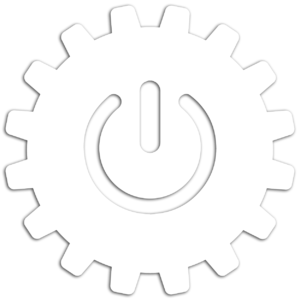
Stage 1: Pre-Design
● It all starts with a question: why is the course being made? The PreDesign stage helps you answer important questions to guide the training
package’s design strategically.
● The questions and outlines of this stage help you decide on many unique
core elements of the training package.
● The Pre-Design stage helps you structure the course to an optimal level.

Stage 2: Training Needs Analysis
● As the course's designer, the Training Needs Analysis stage determines
the performance gap and the depth of the efforts needed to achieve
optimal performance.
● The Training Needs Analysis stage will also assist in preparing and
accounting for possible major constraints that may become showstoppers.

Stage 3: Objectives & Topics
● The Objectives & Topics stage determines objective types to create a
better-formulated skill transfer strategy based on the TNA performance
gap.
● Determining this also prepares for a more immersed visualization,
practice, & theoretical understanding of the skills.

Stage 4: Depth of Practice
● Depth of Practice reflects the relative importance of skills & training
objectives based on the frequency and difficulty for the participants.
● Determine the required training level based on the results and
participants’ needs.

Stage 5: Performance Check
● The Performance Check stage measures participant performance with
training tools that examine the participant's ability to perform tasks and
achieve objectives.
● The Performance Check stage helps ensure skill and knowledge retention
throughout the course and prepare data to calculate actual ROI.

Stage 6: Training Tools
● The Training Tools stage controls multiple vital elements of the training
session that determine the training session's flow, pace, and style.
● This stage also classifies the trainer's role & communication methods
that will be used during the training session while also managing the
participants' level of involvement during every training hour.

Stage 7: Professional Writing
● The Professional Writing stage provides a comprehensive guideline for
the standards of all the written material of the course.
● The written components mainly consist of the Trainees' Notes, Training
Tools, and the Trainer's Manual.
● This stage helps decide the writing methodology and style to distinguish
the training package instructional designer.

Stage 8: Validation & Evaluation
● The Validation & Evaluation stage consists of two phases:
● The Validation phase dictates the effectiveness of your training course
design through a pilot test run to check the validity of the tools, ease of
training, environment, and consistency with time and the participants.
● The Evaluation phase aims to define the feedback method and evaluate
the course design through the users and beneficiaries of the course
during and after its implementation.
Beneficiaries of IMAS™
● Consultant Trainers
● Teachers
● Training Evaluation Specialists
● Human Resources Experts
● Instructional Designers
● Self-Development Specialists
● Training Specialists
● Educational Supervisors
● Training Managers
● Academic Developers

The IMAS™ Advantage
● Analyze and define the participation style and the level of involvement you seek from trainees.
● Craft or select the training tools that will distinguish your training style.
● Connect your innovative training tools with the training objectives to achieve efficiency.
● Identify the trainer’s role appropriately for each training activity.
● Deliver effectiveness by calculating the required time and repetition each skill requires.
The Career Path of Instructional Designers
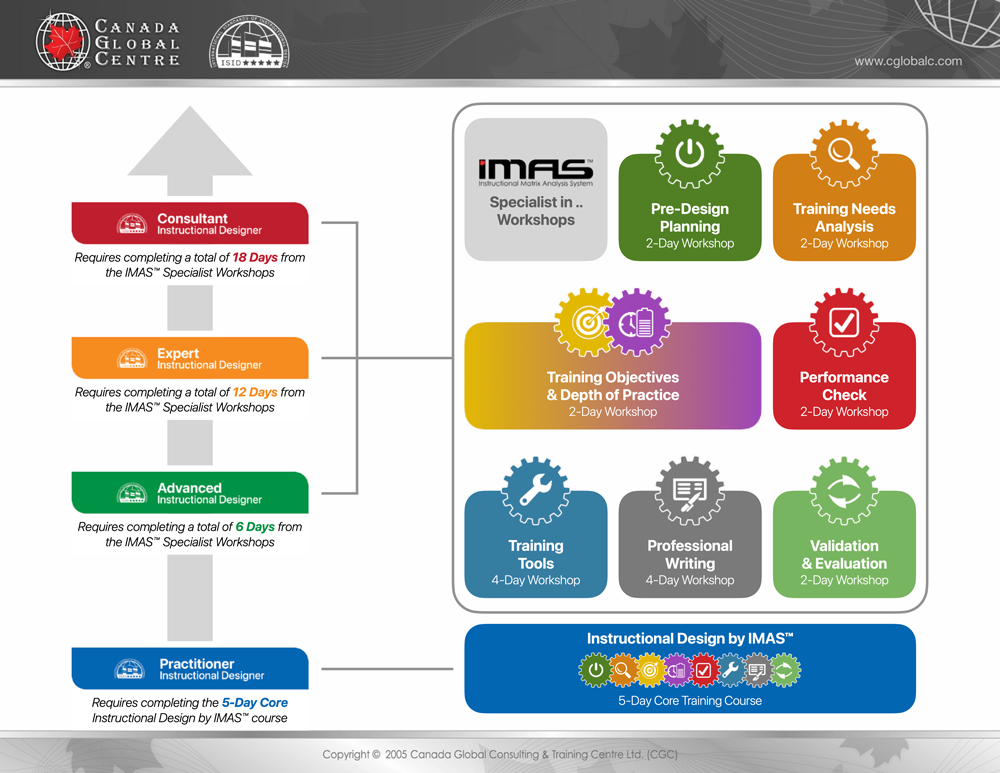
IMAS™ Career Path will assist your growth as an instructional designer by providing you with a clear roadmap to developing your instructional designing skills and nurturing your career with professional designations.
Start your instructional design journey here:



